Does My Website Need To Be ADA Compliant?
- November 29th, 2021
-
Community Spotlight
Marketing
- Swarm Digital
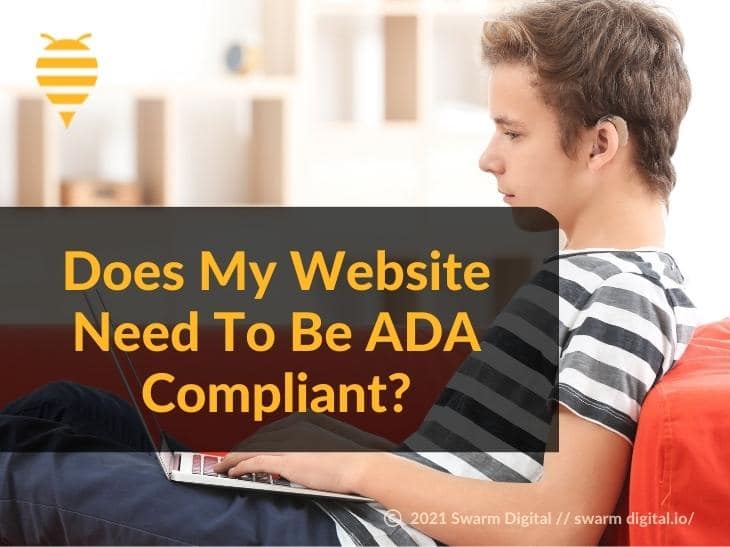
This article will briefly explain what ADA compliance entails and then review what types of websites should strive to be ADA compliant. While you may have heard the term “ADA compliant” used to describe websites, many people do not understand what this compliance means or how to ensure that their website is accessible to all users as defined by the ADA.
In this article, we will discuss the following topics:
- What is ADA compliance?
- How can a website ensure it is ADA compliant?
- What types of websites are required to be ADA compliant?
While the final decisions for your website’s compliance rest with you, we hope that this article will help you understand how accessibility matters and how it affects your website.
What is ADA Compliance?
The phrase “ADA compliant” is often used to describe physical locations that provide unhindered and equal access to persons with disabilities. This access may include but is not limited to wheelchair accessibility, signs with Braille or voice descriptions for individuals with vision limitations, and other means for providing equal access to all.
To understand what this phrase means regarding websites, we will give a short overview of the following points.
- What is the ADA?
- What part of the ADA applies to websites?
- Why is it essential for a website to be ADA compliant?
What is the ADA?
The Americans with Disabilities Act (ADA) is a United States civil rights law enacted in 1990. It prohibits discrimination against people with disabilities. This law describes the types of institutions that must comply with it and the efforts that a company must make to comply with its guidelines. The ADA prevents businesses, specifically government and public entities, from discriminating against persons with disabilities by failing to provide equal and unhindered access to all of the services available to the general public.
Title I of the ADA refers to the accessibility options that must be available for employees of businesses that employ less than 15 persons. Many refer to this as the criteria for whether or not a website should be ADA compliant. However, we will present evidence of why this is invalid.
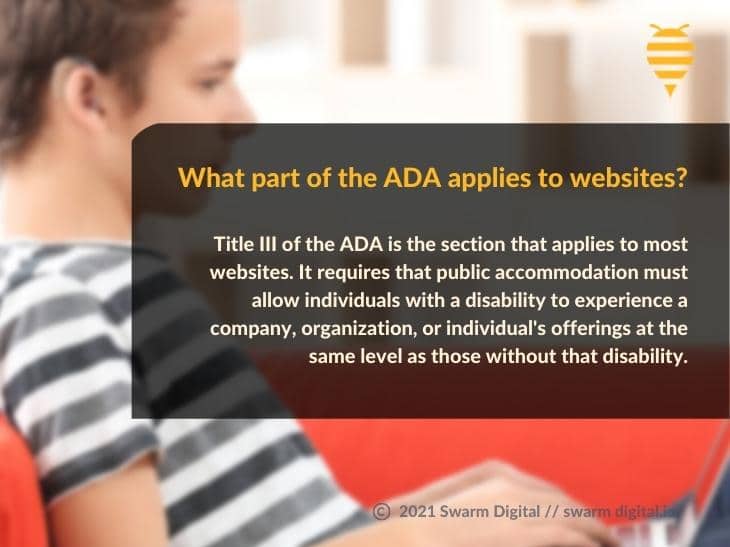
What part of the ADA applies to websites?
Title III of the ADA is the section that applies to most websites. It defines the need for accessibility in any public space. Since most websites are open to all, they are a public space under ADA Title III.
Financial institutions, sports franchises, retail stores, and more have websites that operate for the general public’s benefit. Under the ADA, these websites are considered public accommodation and must comply with the guidelines for providing equal access to all persons with disabilities.
Millions of Americans live with some type of disability that affects their daily life. Some disabilities may include:
- Individuals with impaired vision
- Individuals with impaired hearing
- Individuals sensitive to light patterns
The ADA requires that public accommodation (websites, for our purposes) must allow these individuals to experience a company, organization, or individual’s offerings at the same level as those without that disability.
The tricky part of ADA compliance is that the law was enacted long before the internet became a fixture of modern life. Because of the ambiguity of what exactly “compliance” entails and the dated nature of the law, we need clarification to understand how websites can best serve the needs of persons with disabilities. This clarification comes by looking at how courts have ruled on ADA lawsuits and understanding the Web Content Accessibility Guidelines (WCAG). Thankfully, entities do have flexibility with how they comply with the ADA.
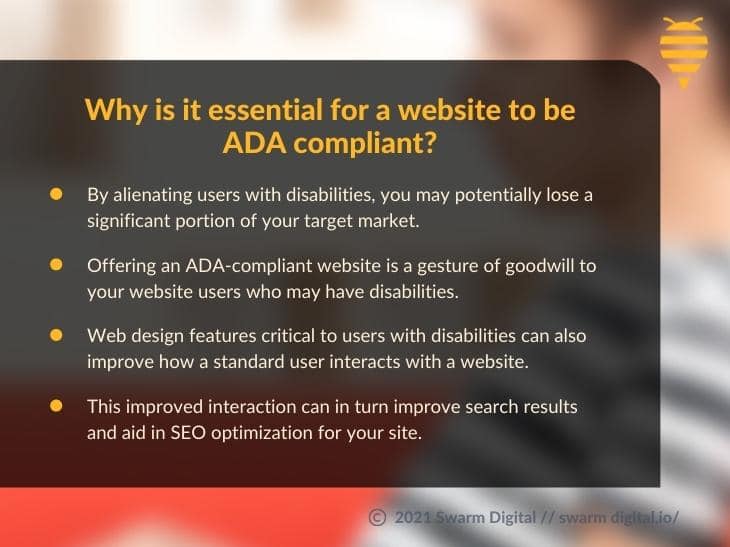
Why is it essential for a website to be ADA compliant?
A website that is not ADA compliant may lose out on the business and support it may otherwise receive. By alienating users with disabilities, an organization or individual may potentially lose a significant portion of its target market. The CDC estimates that 26 million Americans may live with a disability by the year 2030. Regardless of which market a website targets, that is a huge number. Consider also that alienating persons with disabilities also may affect how their loved ones and caregivers interact with a website.
Offering an ADA-compliant website is a gesture of goodwill to your website users who may have disabilities. Even an interest in ADA compliance is a step in that direction. We are thrilled when clients pursue this information, as it can significantly benefit them in the long run. We follow many of the ADA guidelines in Swarm best practices, so our clients reap the benefits without extra effort.
In addition to complying with the ADA, websites that provide accessibility features also tend to work better for the general public. The web design features critical to users with disabilities can also improve how a standard user interacts with a website. For instance, by providing a higher contrast between text and background, an ordinary user may find a website more user-friendly and stay longer on the site. Over time, this can improve search results and aid in SEO for that site.
How can a website ensure it is ADA compliant?
President George H.W. Bush signed the ADA into law before people heavily used the internet. So how are website owners supposed to understand how to comply with ADA standards?
Enter the Web Content Accessibility Guidelines (WCAG). The current standard is 2.1 and outlines how websites can ensure they are providing equal accessibility for everyone. This set of guidelines is the current worldwide standard for accessibility, often referenced in court cases regarding the ADA. It is highly technical and outlines three different levels of compliance.
- Level A is the most basic form of compliance and leaves many obstacles for disabled persons to interact with your website. Level A is not considered ADA compliance.
- Level AA is the targeted level for most websites. The WCAG 2.1 Level AA provides a list of 50 accessibility checks that help ensure compliance.
- Level AAA is the highest standard of accessibility. For some content, it may not be possible to achieve Level AAA compliance.
Thankfully, there is flexibility for how an entity can choose to provide compliance to ADA. The generally accepted method is to make websites more accessible, but there are other options. For instance, a company may choose to provide a phone-in option for users who require additional assistance.
However, this may prove cost-prohibitive. Consider that websites are available 24/7 to the general public. In order to reach equal accessibility, the phone-in service would have to be available 24/7 as well. Generally speaking, the most effective way to comply with ADA guidelines is to optimize your website to fit the WCAG 2.1 guidelines, hopefully achieving Level AA compliance.
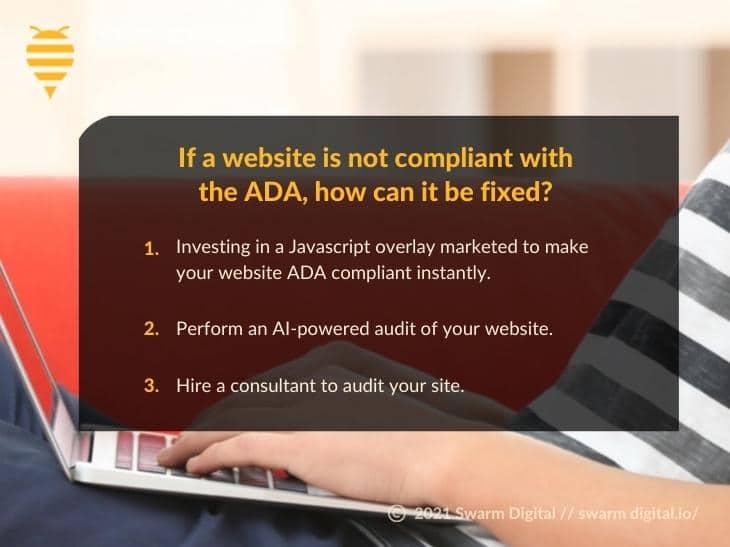
If a website is not compliant with the ADA, how can it be fixed?
There are a few commonly-tried ways of ensuring ADA compliance. These include:
- Investing in a Javascript overlay marketed to make your website ADA compliant instantly.
- Perform an AI-powered audit of your website.
- Hire a consultant to audit your site.
We will review these options and discuss their merits and disadvantages.
Javascript overlay or widget
Experts and individuals with experience in ADA compliance will never recommend a web overlay to increase ADA compliance. Reasons why this option is not effective include:
- An overlay may interfere with users who use an assistive technology device. This makes your website less effective for the user than it would have been without the overlay.
- Overlays do not fix the root issues of website non-compliance and are often cumbersome to use.
- Widgets and overlays are a “separate and unequal experience,” which violates the ADA.
- Many lawyers have successfully sued websites with widgets and overlays for non-compliance with the ADA.
AI-powered audit of a website
The power of AI is continually growing, and some technology can help identify accessibility pitfalls on a website. WAVE is an automated accessibility checker available as a browser extension. It is a popular resource that shows accessibility errors and alerts on a website. While WAVE and similar technologies are helpful, they can’t catch all of the potential pitfalls of ADA non-compliance. Using these technology solutions is an excellent first step toward ensuring accessibility on your website, but they can only find a small portion of the possible errors. To fully comply with the ADA, you would need to go one step further.
Hire a consultant to audit your site
While this step may be cost-inhibitive, especially for large websites, this is the only method that ensures accurate compliance to the ADA and WCAG guidelines. Considering that legal fees for a lawsuit almost always exceed $5,000, the money spent on a website audit can save organizations and individuals a great deal of time and money in the long run.
After receiving a website audit, the errors pointed out should be satisfactorily remediated for that website to be considered ADA compliant and relatively safe from legal action.
Swarm is happy to assist with any questions you have regarding ADA compliance and help you improve accessibility on your website. Our team understands the varied interest in ADA compliance and respects website owners’ right to make the final decision regarding the accessibility of their website.
What types of websites are required to be ADA compliant?
While the ADA does not technically state that websites are required to comply with accessibility guidelines, the spirit of the ADA does cover the use of the internet. The overwhelming majority of court cases involving website accessibility reinforce this fact. There is an ever-growing cottage industry of lawyers and law firms that specifically target websites with lawsuits and demand letters. Since the ADA clearly states that the defendant must pay all of the plaintiff’s legal fees, a disabled user or a law firm has nothing to lose by filing a lawsuit.
Does your website provide public accommodation (i.e., is it available to the general public)? Then it is recommended that your website should strive for ADA compliance where possible.
There are twelve categories in Title III of the ADA that specify the private entities considered places of public accommodation for its purposes. Any organization, non-profit, or company with a website may be subject to compliance with the ADA, even if it does not operate from a specific physical location. While some refer to the 15-employee rule for a loophole in the ADA guidelines, this specification is made for physical locations and does not apply to websites.
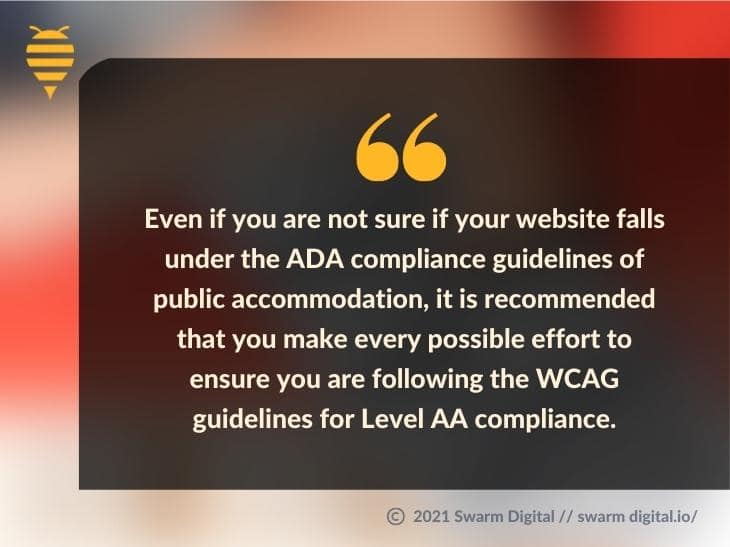
What if I’m still not sure?
Even if you are not sure if your website falls under the ADA compliance guidelines of public accommodation, it is recommended that you make every possible effort to ensure you are following the WCAG guidelines for Level AA compliance. Some of the reasons you should consider ADA compliance are:
- Even if you are not sure if your website falls under the ADA compliance guidelines of public accommodation, it is still a good idea to make an effort to follow the WCAG guidelines for Level AA compliance. Some of the reasons you may consider ADA compliance are:
- Lawyers often target non-compliant websites.
- You may gain support or business revenue by having a site with better accessibility.
- Equal opportunity is widely considered a fundamental social right. Offering disabled users better access to your website is a sign of goodwill toward a large portion of users.
Need help with ADA compliance on your website?
Taking preventative measures to ensure your website is accessible for all users can save you time and money down the road. A non-compliant website’s risks can be troublesome for any business but especially detrimental to medium and small-size companies.
The guidelines and recommendations outlined in WCAG 2.1 Level AA are quite technical, dealing with HTML code, media alt tags, and more. Finding this a daunting task to update your website? Are you seeking to offer your website in a more accessible format to all users?
We would be happy to provide a free consultation to assess your website’s needs and how we can address solutions. If you find yourself needing help, please contact us, and we will be happy to help.
